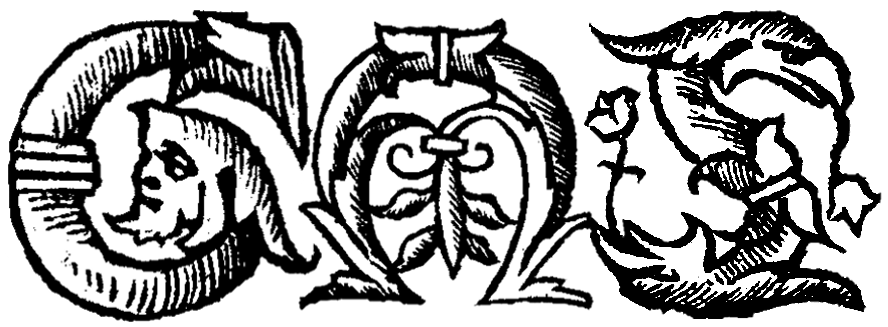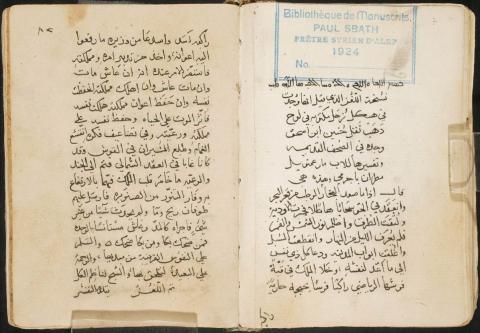Copy of the riddle that was said to have been found in the temple of Saturn written on a golden tablet | نسخة اللغز الذي قيل انها وجدت في هيكل زحل مكتوبة في لوح ذهب
Introduction to the Text
The rubric of this text explains its existence in the most dramatic way: it was purportedly found in the temple of Saturn (Arabic Zuḥal), written on a golden tablet, at some unspecified ancient date. The location of the “temple of Saturn” is also not specified, but we may assume that it is meant to be located somewhere in Iraq or upper Mesopotamia, perhaps in the city of Harran, famous in the early Islamic period for its lingering cult of astrological polytheism. The rubric next tells us that the text was later rediscovered in “ancient pages” and translated into Arabic by Ḥunayn ibn Isḥāq (ca. 809-873), an East Syrian Christian (member of the Church of the East) who became famous as the most important figure in the Baghdad translation movement that brought ancient philosophical and scientific texts into Arabic under the early ʻAbbāsid caliphs. The source language from which the riddle was translated is not stated, but is likely meant to be Syriac. Ḥunayn may in fact be responsible for the composition and/or translation of this text, but it is entirely possible that he is mentioned pseudonymously in order to associate the text with one of the most famous Christian scholars to write in Arabic. The text is accompanied by a commentary by ʻAmanúʼél d-Bét Garmay (d. 1080), an East Syrian metropolitan (archbishop) from northern Iraq (modern Kirkuk).
The rubric identifies the text as a “riddle” or “enigma” (lughz), but it fits uneasily in the context of other Arabic texts that use this term. Arabic riddles are generally written in an interrogative format and often in poetic meter, while this text is prose. There is no obvious “riddle” that could be answered here, but it seems the term is used to emphasize the cryptic nature of the text and its need for explanation, a task that ʻAmanúʼél attempts in his commentary. The riddle paints an apocalyptic picture that draws both on astrological references and on the story of Noah’s flood, especially in its Qur’anic form. It tells of a selfish king who decides, in a time of crisis, to pursue his own individual goals and abandon his kingdom to ruin. In the commentary, not included here, ʻAmanúʼél interprets the text as an allegory for the coming of Christ and the rise of Christianity, arguing that many philosophically-minded non-Christians have some awareness of Christian truth, even if they express it in different terms. The end of the commentary is lost, as noted by the scribe who copied this manuscript from an incomplete exemplar.
In addition to the fascinating frame story that is provided for this text, it is interesting for its apparent connection to nearly every major religious tradition of the early medieval Middle East, including less widely known traditions such as Harranian polytheism. Many Christians of this period were deeply aware of their non-Christian neighbors, and some of them drew on this knowledge to compose an enigmatic and intriguing text. Nevertheless, there has so far been little to no scholarly attention paid to the text.
Introduction to the Source
The sole known manuscript of the riddle is Fondation Georges et Mathilde Salem MS Syr 6, one of the hundreds of manuscripts collected by Syriac Catholic priest Paul Sbath (1887-1945) that remains in his hometown of Aleppo (formerly Sbath MS 900). It was copied in September 1684 and also includes an Arabic translation of the Book of the dove by Bar Hebraeus (1226-1286), an important Syriac text on asceticism. The Arabic Life of Moses the Ethiopian (d. ca. 395) was copied separately and later bound with these texts. The entire volume is thus written in the Arabic language, but the vast majority of it is actually in Arabic Garshuni—that is, Arabic written in the Syriac script. Interestingly, the text of the riddle is copied in Arabic script, but the commentary on it is copied in Garshuni, making it easy to distinguish text and commentary visually. This may have been done to preserve the original form of the Arabic text associated with Ḥunayn, but it is not explained.
The scribe of this manuscript is Yūḥanná ibn al-Jarīr al-Zarbābī, who was a West Syrian priest (member of the Syriac Orthodox Church) in Damascus. This shows that al-Zarbābī was not limited to copying texts by members of his own Church, like the Book of the dove, but was interested enough in this riddle to copy it in spite of its association with two figures from the rival Church of the East.
The condition of the manuscript is unknown due to the lengthy civil war in Syria, but it was photographed in 2008 and digitized by the Hill Museum and Manuscript Library (HMML). It is available for viewing at https://w3id.org/vhmml/readingRoom/view/501459. The text of the riddle appears on fol. 82v-83r and the commentary on fol. 83v-93v.
About this Edition
I have transcribed and translated the text from Salem MS Syr 6, its only known copy. I have generally maintained the spelling of the manuscript, including the usual omission of the Arabic letter hamzah (ء) that marks the glottal stop, but have standardized the dots on several letters that sometimes appear without them. The manuscript includes a surprising number of short vowel and case markings, but these have been omitted in transcription. The text repeated in the commentary sometimes differs slightly from the text given on its own, but I have tried to stick to the latter form insofar as it is legible and comprehensible. There are few punctuation marks in the text, as with most premodern Arabic texts, and I have added a few additional periods in order to help organize the sentences.
In addition to the commentary (not included here), the trinitarian invocation at the head of the text is written in Arabic Garshuni, which I have retained in transcription. I wrote the translation of this invocation in ALL CAPS as a way to mark the difference of script.
Further Reading
Bencheneb, M. “Lug̲h̲z.” Encyclopaedia of Islam, 2nd ed., Brill, 2012.
- Introduction to the Arabic riddle and closely related genres.
Green, Tamara M. The City of the Moon God: Religious Traditions of Harran. Brill, 1992.
- Discussion of the unique religious context of this important city of upper Mesopotamia.
Griffith, Sidney H. The Church in the Shadow of the Mosque: Christians and Muslims in the World of Islam. Princeton UP, 2008.
- Foundational introduction to the first few centuries of Christian life under Muslim rule and to the various Syriac and Arabic Churches.
Gutas, Dimitri. Greek Thought, Arabic Culture: The Graeco-Arabic Translation Movement in Baghdad and Early ʻAbbāsid Society. Routledge, 1998.
- Most influential discussion of the translation movement.
Credits
Transcription by Joshua MuglerTranslation by Joshua MuglerEncoded in TEI P5 XML by Danny SmithSuggested citation: Anonymous. "Copy of the riddle that was said to have been found in the temple of Saturn written on a golden tablet." Trans. Joshua Mugler. Global Medieval Sourcebook. http://sourcebook.stanford.edu/text/copy-riddle-was-said-have-been-found.... Retrieved on April 26, 2024.

